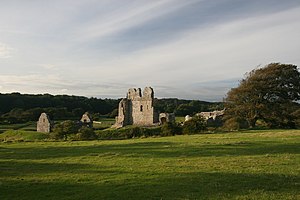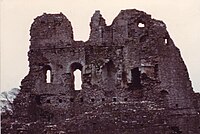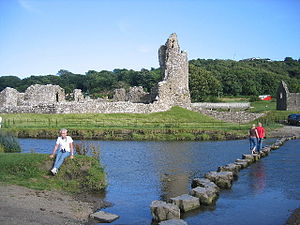Ogmore Castle: Difference between revisions
Created page with "thumb|300px|Ogmore Castle and grounds '''Ogmore Castle''' is a Grade I listed castle ruin located near the village of Ogmore-by-Sea, south..." |
No edit summary |
||
| (One intermediate revision by one other user not shown) | |||
| Line 2: | Line 2: | ||
'''Ogmore Castle''' is a Grade I listed castle ruin located near the village of [[Ogmore-by-Sea]], south of the town of [[Bridgend]] in [[Glamorgan]]. It is situated on the south bank of the [[River Ewenny]] and the east bank of the [[River Ogmore]].<ref>{{cite web| url= http://www.britishlistedbuildings.co.uk/wa-21793-ogmore-castle-st-brides-major|title= Ogmore Castle, St Bride's Major|publisher= British Listed Buildings|accessdate = 22 July 2015}}</ref> | '''Ogmore Castle''' is a Grade I listed castle ruin located near the village of [[Ogmore-by-Sea]], south of the town of [[Bridgend]] in [[Glamorgan]]. It is situated on the south bank of the [[River Ewenny]] and the east bank of the [[River Ogmore]].<ref>{{cite web| url= http://www.britishlistedbuildings.co.uk/wa-21793-ogmore-castle-st-brides-major|title= Ogmore Castle, St Bride's Major|publisher= British Listed Buildings|accessdate = 22 July 2015}}</ref> | ||
Its construction might have begun in 1106.<ref name="Hull2006">{{cite book|last=Hull|first=Lise|title=Britain's Medieval Castles|url=http://books.google.com/books?id=fBbNJLEWiLIC&pg=PA102|accessdate=8 February 2011|year=2006|publisher=Greenwood Publishing Group|isbn=978-0-275-98414-4|pages=102–}}</ref> Ogmore was one of three castles built in the area in the early 12th century, the others being [[Coity Castle]] and [[Newcastle Castle, | Its construction might have begun in 1106.<ref name="Hull2006">{{cite book|last=Hull|first=Lise|title=Britain's Medieval Castles|url=http://books.google.com/books?id=fBbNJLEWiLIC&pg=PA102|accessdate=8 February 2011|year=2006|publisher=Greenwood Publishing Group|isbn=978-0-275-98414-4|pages=102–}}</ref> Ogmore was one of three castles built in the area in the early 12th century, the others being [[Coity Castle]] and [[Newcastle Castle, Glamorgan|Newcastle Castle]]. It was in use until the 19th century for a range of purposes, including a court of justice and a prison, but is now a substantial set of remains and a local landmark. It is managed by local authorities.<ref>Hull, p. 203</ref> | ||
==Etymology== | ==Etymology== | ||
| Line 26: | Line 26: | ||
A deep, rock-cut ditch surrounded the castle grounds, which were dry except when the River Ewenny flooded the area during high tide.<ref name="Hull2006" /> While the ditch that enclosed the castle's inner bailey filled at high tide, the flow was regulated by an embedded stone wall that blocked rising waters so that the interior of the castle did not flood.<ref name="Hull2008">{{cite book|author=Hull, Lise|title=Understanding the Castle Ruins of England and Wales: How to Interpret the History and Meaning of Masonry and Earthworks|url=http://books.google.com/books?id=p_S0DVi3vBEC&pg=PA45|accessdate=8 February 2011|date=December 2008|publisher=McFarland|isbn=978-0-7864-3457-2|pages=45–}}</ref> | A deep, rock-cut ditch surrounded the castle grounds, which were dry except when the River Ewenny flooded the area during high tide.<ref name="Hull2006" /> While the ditch that enclosed the castle's inner bailey filled at high tide, the flow was regulated by an embedded stone wall that blocked rising waters so that the interior of the castle did not flood.<ref name="Hull2008">{{cite book|author=Hull, Lise|title=Understanding the Castle Ruins of England and Wales: How to Interpret the History and Meaning of Masonry and Earthworks|url=http://books.google.com/books?id=p_S0DVi3vBEC&pg=PA45|accessdate=8 February 2011|date=December 2008|publisher=McFarland|isbn=978-0-7864-3457-2|pages=45–}}</ref> | ||
Looking towards the sea from the castle ruins, the view includes | Looking towards the sea from the castle ruins, the view includes sandhills that proceed up the coast nearly as far as the town of [[Briton Ferry]]. Opposite from Ogmore Castle is [[Merthyr Mawr]], where there are two sculptured crosses;<ref name="Murray1860">{{cite book|last=Murray |first=John|title=A handbook for travellers in South Wales and its borders, including the river Wye: With a travelling map|url=http://books.google.com/books?id=zuUBAAAAMAAJ&pg=PA16|accessdate=8 February 2011|year=1860|publisher=J. Murray|pages=16–}}</ref> the village can be reached by a footpath from the castle. | ||
Also near the castle are a popular set of stepping stones across the river which are a Scheduled Ancient Monument.<ref>{{cite web| url=http://map.coflein.gov.uk/index.php?action=do_advanced&pnprn=32814|title= OGMORE CASTLE, STEPPING STONES|publisher= Royal Commission on the Ancient and Historical Monuments of Wales|accessdate = 22 July 2015}}</ref> A short distance to the southeast are several shallows filled with water that are said to have sunk spontaneously. One of them is circular, measuring approximately 7 ft in diameter.<ref name="Nicholson1840" /> | Also near the castle are a popular set of stepping stones across the river which are a Scheduled Ancient Monument.<ref>{{cite web| url=http://map.coflein.gov.uk/index.php?action=do_advanced&pnprn=32814|title= OGMORE CASTLE, STEPPING STONES|publisher= Royal Commission on the Ancient and Historical Monuments of Wales|accessdate = 22 July 2015}}</ref> A short distance to the southeast are several shallows filled with water that are said to have sunk spontaneously. One of them is circular, measuring approximately 7 ft in diameter.<ref name="Nicholson1840" /> | ||
| Line 38: | Line 38: | ||
==Outside links== | ==Outside links== | ||
{{commons category}} | {{commons category}} | ||
*Location map: {{wmap|51.47995|-3.61278|zoom=14}} | *Location map: {{wmap|51.47995|-3.61278|zoom=14|name=Ogmore Castle}} | ||
*[http://www.castlewales.com/ogmore.html Castles of Wales website] (includes other photos and further historical background) | *[http://www.castlewales.com/ogmore.html Castles of Wales website] (includes other photos and further historical background) | ||
*[http://www.castles99.ukprint.com/glamorgan.html Anglo-Norman Castles] | *[http://www.castles99.ukprint.com/glamorgan.html Anglo-Norman Castles] | ||
Latest revision as of 13:18, 1 September 2022

Ogmore Castle is a Grade I listed castle ruin located near the village of Ogmore-by-Sea, south of the town of Bridgend in Glamorgan. It is situated on the south bank of the River Ewenny and the east bank of the River Ogmore.[1]
Its construction might have begun in 1106.[2] Ogmore was one of three castles built in the area in the early 12th century, the others being Coity Castle and Newcastle Castle. It was in use until the 19th century for a range of purposes, including a court of justice and a prison, but is now a substantial set of remains and a local landmark. It is managed by local authorities.[3]
Etymology
When John Leland wrote his Itinerary, he referred to this fortress as "Ogor Castelle".[4][5] The name comes from the nearby river, the River Ogmore.
History

Construction of Ogmore Castle might have started around 1106,[2] its foundation predating the Norman conquest.[4] In Caradoc of Llancarfan's The historie of Cambria, now called Wales: a part of the most famous yland of Brytaine, Caradoc wrote that the manor and castle were given to William de Londres, one of the legendary Twelve Knights of Glamorgan, by Robert Fitzhamon, the Norman conqueror of Glamorgan.[6] In 1116, William de Londres was forced to abandon the castle when the Welsh appeared in force.[7] His butler, Arnold, is credited with protecting the castle from the Welsh attack during the absence of William de Londres, and for this, he was knighted Sir Arnold Butler, also receiving the castle and manor of Dunraven as reward.[8]
According to the custom of the times, the founding of a religious institution followed the acquisition of power. William de Londres, or his descendant John, built Ewenny Abbey a mile from the castle. Also nearby was a religious place appended to Ogmore Castle by Morris de Londres or his descendant John, in 1141; Ewenny Priory is two miles from Ogmore Castle. When Thomas' heiress married into the Chaworth family of Kidwelly,[7] the lands passed in 1298 to the first Duke of Lancaster.[5]
Architecture
The earthworks were steeply banked and oval in shape, enclosing an area of 164 ft in length by 115 ft in width. The inner ward was flat and constructed of timber structures. After completion of the ringwork, the building material was stone. The windows were round-headed with Sutton stone ashlar. The first-floor great hall had an ornate fireplace.[2]
William's son Maurice is credited with building the oblong keep; it is perhaps the oldest Norman keep in Glamorgan.[7] Situated north of the main gateway, the keep was the first masonry building and was probably built in the 1120s. It is both the castle's tallest surviving building, and one of the oldest buildings in South Wales. Though only three of the original walls survive, their structure is characterized by irregularly shaped field stones, glacial pebbles, Lias limestone slabs, and brown mortar. Thomas de Londres replaced a timber palisade with a stone wall in around 1200.[7]
In the early 13th century, a second storey was added that housed private apartments. Garderobes were featured on two levels and a latrine tower was part of the exterior.[2] A well-preserved lime kiln was built over an indeterminate 13th-century structure. Subsequently, a courthouse dating to the 14th century and rebuilt in the mid-15th century, was probably the third building to occupy the same spot. The building was rectangular in shape with a simple doorway and was flanked by two chambers. Having sustained damage during Owain Glyndŵr's revolt, a new courthouse, situated in the castle's outer bailey, was built in 1454 and was in use until at least 1631.[2][7]
The present-day castle remains consist of the keep and some outer walls.[4]
Grounds

A deep, rock-cut ditch surrounded the castle grounds, which were dry except when the River Ewenny flooded the area during high tide.[2] While the ditch that enclosed the castle's inner bailey filled at high tide, the flow was regulated by an embedded stone wall that blocked rising waters so that the interior of the castle did not flood.[9]
Looking towards the sea from the castle ruins, the view includes sandhills that proceed up the coast nearly as far as the town of Briton Ferry. Opposite from Ogmore Castle is Merthyr Mawr, where there are two sculptured crosses;[10] the village can be reached by a footpath from the castle.
Also near the castle are a popular set of stepping stones across the river which are a Scheduled Ancient Monument.[11] A short distance to the southeast are several shallows filled with water that are said to have sunk spontaneously. One of them is circular, measuring approximately 7 ft in diameter.[4]
Folk tales
The ghost Y Ladi Wen ("the White Lady") purportedly guarded the castle's treasure and Lady Wen's revenge was said to fall on the person who died prior to disclosing hidden treasure.[12][13]
References
- ↑ "Ogmore Castle, St Bride's Major". British Listed Buildings. http://www.britishlistedbuildings.co.uk/wa-21793-ogmore-castle-st-brides-major. Retrieved 22 July 2015.
- ↑ 2.0 2.1 2.2 2.3 2.4 2.5 Hull, Lise (2006). Britain's Medieval Castles. Greenwood Publishing Group. pp. 102–. ISBN 978-0-275-98414-4. http://books.google.com/books?id=fBbNJLEWiLIC&pg=PA102. Retrieved 8 February 2011. Cite error: Invalid
<ref>tag; name "Hull2006" defined multiple times with different content - ↑ Hull, p. 203
- ↑ 4.0 4.1 4.2 4.3 Nicholson, George (1840). The Cambrian traveller's guide, and pocket companion [by G. Nicholson.]. pp. 117–. http://books.google.com/books?id=z70HAAAAQAAJ&pg=PA117. Retrieved 7 February 2011.
- ↑ 5.0 5.1 Lewis, Samuel (1833). A topographical dictionary of Wales: comprising the several counties, cities, boroughs, corporate and market towns, parishes, chapelries, and townships, with historical and statistical descriptions : illustrated by maps of the different counties ; and a map of Wales, shewing the principal towns, roads, railways, navigable rivers, and canals ; and embellished with engravings of the arms of the cities, bishopricks, corporate towns, and boroughs ; and of the seals of the several municipal corporations ; with an appendix describing the electoral boundaries of the several boroughs, as defined by the late act. Lewis and Co.. pp. 131–. http://books.google.com/books?id=IsU_AAAAcAAJ&pg=PT131. Retrieved 7 February 2011.
- ↑ Cruttwell, Clement (1801). A tour through the whole island of Great Britain: divided into journeys. Interspersed with useful observations; particularly calculated for the use of those who are desirous of travelling over England & Scotland. Printed for G. & J. Robinson. pp. 176–. http://books.google.com/books?id=sAApAAAAYAAJ&pg=PA176. Retrieved 8 February 2011.
- ↑ 7.0 7.1 7.2 7.3 7.4 Pettifer, Adrian (2000). Welsh Castles: A Guide by Counties. Boydell & Brewer. pp. 102–. ISBN 978-0-85115-778-8. http://books.google.com/books?id=Hs5DnKUSu9gC&pg=PA102. Retrieved 8 February 2011.
- ↑ Nicholson, p. 131
- ↑ Hull, Lise (December 2008). Understanding the Castle Ruins of England and Wales: How to Interpret the History and Meaning of Masonry and Earthworks. McFarland. pp. 45–. ISBN 978-0-7864-3457-2. http://books.google.com/books?id=p_S0DVi3vBEC&pg=PA45. Retrieved 8 February 2011.
- ↑ Murray, John (1860). A handbook for travellers in South Wales and its borders, including the river Wye: With a travelling map. J. Murray. pp. 16–. http://books.google.com/books?id=zuUBAAAAMAAJ&pg=PA16. Retrieved 8 February 2011.
- ↑ "OGMORE CASTLE, STEPPING STONES". Royal Commission on the Ancient and Historical Monuments of Wales. http://map.coflein.gov.uk/index.php?action=do_advanced&pnprn=32814. Retrieved 22 July 2015.
- ↑ Gwyndaf, Robin (1989). Welsh Folk Tales. National Museum Wales. pp. 59–. ISBN 978-0-7200-0326-0. http://books.google.com/books?id=ApSEknvrLboC&pg=PA59. Retrieved 8 February 2011.
- ↑ "Stori Castell Ogwr ("The Legend of Ogmore Castle")" (in Welsh). bridgend.gov.uk. http://docs.google.com/viewer?a=v&q=cache:HNdYQYfdvokJ:www.bgfl.bridgend.gov.uk/Teachers/Resources/welsh/Themau_a_Storiau/Y_Ladi_Wen.ppt+%22Y+Ladi+Wen%22&hl=en&gl=us&pid=bl&srcid=ADGEESg2nhJQFoM2ehpsYJtIwqwSulp4cpL0pZJbiDul6Nr_rpn8HwjDDEPhw02sXu-urlOeS4pg-tHbbKe8rZJvmK7zb9SLTzplMLjC0kb3E0Vys-TuKvebOgBnCzpDd1BwTJ_sxA-T&sig=AHIEtbRZcoX2BuOMrYRapKdJyiU5N-xzRQ. Retrieved 9 February 2011.
Outside links
| ("Wikimedia Commons" has material about Castle Ogmore Castle) |
- Location map: 51°28’48"N, 3°36’46"W
- Castles of Wales website (includes other photos and further historical background)
- Anglo-Norman Castles
- www.geograph.co.uk : photos of Ogmore Castle
- BBC Wales panoramic of the castle
